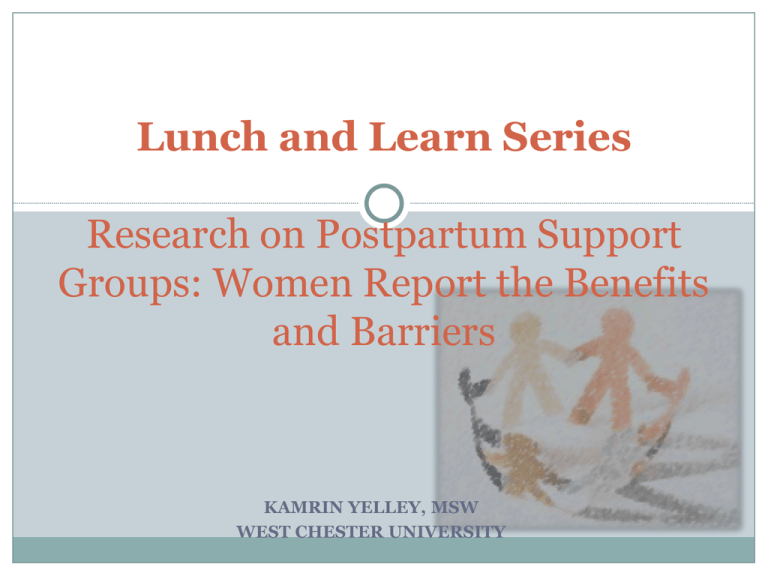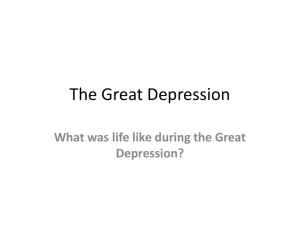Lunch and Learn Powerpoint - AASWG Southern California
advertisement

Lunch and Learn Series Research on Postpartum Support Groups: Women Report the Benefits and Barriers KAMRIN YELLEY, MSW WEST CHESTER UNIVERSITY Objectives Attendees will better understand the importance of support groups for women with postpartum depression. 2. Attendees will be able to describe strategies for facilitating effective support groups for women with postpartum depression. 3. Attendees will be better informed about relevant postpartum depression literature. 4. Areas of need for postpartum depression support groups will be discussed. 1. Background: What is Postpartum Depression? My interest in the topic: internship at Phoenixville Hospital (Phoenixville, PA) working with new mothers directly after birth, and providing education on PPD. Postpartum depression is “moderate to severe depression” that a woman may experience after giving birth. It typically occurs within three months of delivery, but can occur up to one year after the birth of the baby. Postpartum depression can affect any woman, regardless of race, age or economic background. Depression and Bipolar Support Alliance, 2010 Background: What is Postpartum Depression? Up to 85% of women experience some mild mood disturbance after birth. 10-15% of women experience a more disabling and persistent form of depression called postpartum depression, and another, 0.1-0.2% of women experience postpartum psychosis. Postpartum psychosis is very rare, but very serious. The symptoms include hallucinations, rapid mood swings, and attempts to hurt oneself or the baby. Post Partum Depression Educational Video -New Jersey http://youtu.be/yH3WMQO-ooU O’Hara, Neunaber & Zekoski, 1984; Women’s Health, 2009; Insel, 2010; Cox, 2010. Background: What is Postpartum Depression? In the United States in 2011, 4 million births occurred. According to the above prevalence rates, at least 400,000 women experienced PPD last year and approximately 4,000 experienced postpartum psychosis. 2010 California Birth rate was 510,000 births. In California, conservatively 51,000 women experienced PPD that year. After Melanie Blocker-Stokes committed suicide in 2001 while suffering from postpartum psychosis, the Melanie Blocker-Stokes Mothers Act passed in 2009. This act provides support for research into the causes, diagnoses, and treatment of postpartum depression and psychosis. O’Hara, Neunaber & Zekoski, 1984; Women’s Health, 2009; Insel, 2010; Cox, 2010; CA Dept of Public Health. Background: Literature Review Little research is currently available on the effectiveness of support groups when working with women with PPD. Of the seventy five articles I reviewed on PPD, only five studied postpartum support groups, and the results of the studies varied from finding the support groups effective to believing them to be harmful to participants’ self-esteem. DiMascio et al, 2008 Literature Review: Article One In DiMascio et al's article “Recovery from postnatal depression: A consumer's perspective” written in 2008, the researchers had women identify what they found to be effective in recovering from postpartum depression 95.6% of the women surveyed ranked support groups as “very important” for their recovery DiMascio et al, 2008 Literature Review: Article Two Lane et al., 2010 was POSITIVE “It's just different in the country: postnatal depression and group therapy in a rural setting” This article showed that all participants achieved a lower Edinburgh Postnatal Depression Scale (EPDS) score by the end of the group. DiMascio et al, 2008 Literature Review: Article Three Armstrong and Edwards, 2003 was AMBIVALENT “The effects of exercise and social support on mothers reporting depressive symptoms: A pilot randomized controlled trial” This article researched the effectiveness of exercise and social support groups on reducing PPD symptoms. The exercise group reduced depressive DiMascio et al, 2008 Literature Review: Article Four Fleming et al., 1992 was NEGATIVE “The effects of social support groups on depression, maternal attitudes, and behavior in new mothers” The researcher found that regardless of the intervention, mothers moods improved over time. And they found that social support groups possibly had a negative effect on the self-confidence of women who were depressed. They believe this could be due to a “comparison effect”, or a mother's perception that she was worse than the rest of the group participants. DiMascio et al, 2008 Literature Review: Article Five Webster et al., 2001 was POSSIBLY NEGATIVE “Postnatal depression: Use of health services and satisfaction with health care providers” In this study, 30% of the women with PPD who attended support groups found them to not be helpful. DiMascio et al, 2008 Problem The findings of the literature review reflect that more specific research is needed in the area of support groups. The purpose of my research was to evaluate participant's perceptions of the effectiveness of postpartum depression support groups. Research Design Non-experimental, exploratory study of perceptions on the effectiveness of support groups. No control group was used. Mixed-design study, with open-ended questions that were evaluated for themes/trends related to perceptions of the effectiveness of the group. I attended the support group, and the group facilitator collected data in my absence. Subjects received and completed their questionnaires at the end of the support group. Data Collection Subjects completed the Edinburgh Postnatal Depression Scale, which determines depression. A score of ten was used to screen for PPD. EPDS has been used in multiple studies to determine PPD. A questionnaire had already been developed by the hospital to evaluate the effectiveness of the support group. I used the same survey instrument and added more questions that were relevant to my research. Informed consent was obtained before conducting research. Data Collection Convenience sample: The support group is advertised on the hospital website, and through community education programs. Subjects are typically referred to the support group by professionals and through a postpartum stress center, and referrals come from other hospitals or through other members of the community. The data collected during observation of the support group and from the questionnaires was analyzed for themes about the effectiveness of the support group. Direct quotes are identified that support these themes. The Support Group I was able to participate as a guest of the support group, which has been running for approximately five years now. It is co-facilitated by a postpartum center nurse and a hospital social worker. Membership typically includes a small core-group of 5 members who attended for 1-2 years and are slowly replaced by a new core-group, and then several others who attend a few meetings while in crisis. The group meets once per month for two hours from 6:30-8:30pm and childcare is provided by hospital volunteers. The meeting begins with introductions and welcome, and then moves quickly into discussion of participant concerns about PPD. The Support Group The meeting is ended with a quick summary, since it typically runs over time. Also, some months a guest speaker is invited to provide information the participants have requested. All participants are new mothers, and have experienced or are experiencing PPD or other stressors. I also want to mention that members are active in leadership roles, recruitment of new participants, and advocating for themselves in the political arena. Results: Demographics 19 of the 20 participants in the support group are White. 1 participant is Hispanic. Ages ranged from 27 to 40, with three participants choosing to not answer this question. The mode age is 39 years. 10 percent of participants have 3 children, 20 percent have 2, and 70 percent have 1. Most of the participants had been referred by a professional to the group. The remainder were referred by friends, and one was referred by another group. This allows us to understand who is referring, and where we should focus efforts on education about the support group if we want to increase attendance. Results The support group is perceived as effective by participants. I came to this conclusion because: All 20 participants found the group to be “Very Helpful” or “Extremely Helpful”. The median and mode score for the eight questions referring to satisfaction with the group is 5, with 5 being the highest score possible. The mean scores for each question are 4.75 and higher. Results: Themes From the open-ended questions and observation of the group, four themes were identified regarding the effectiveness of the support group. Normalizing “It was helpful to hear from other women and know that my thoughts and what I was going through was okay and could be conquered. That PPD is not scary, wrong, or something I did to myself or did wrong. That PPD is something that can be overcome, and that there is a powerful caring community of women”. Supportive Structure One participant said it was helpful to know that “We are there for each other to support each other through this challenging time”. Another participant explained that “other people mean well, but they really just don't understand it. I don't think they mean to be insensitive but they have no idea. Until you go through [postpartum depression] you can't know what it is”. Results: Themes Increased Confidence “I realized 'It's all on you. You don't need [person's name] anymore. You can handle this now.' Things are getting better and I can do this now”. During the time in which they have participated in the group, members have come to believe that they can manage and understand their postpartum depression. Decreased self-blame “we don't have to feel guilty about having negative feelings. You can be grateful to be a mom, but still get upset”. Areas of need The areas of need include: more structure, guest speakers who can provide educational information, assigned themes for meetings, and more outreach efforts to support women who are not attending the support group. Discussion Findings Participants were very satisfied with the support group, in managing symptoms and positively changing behaviors to cope with their negative symptoms. Most of the participants felt no change was needed to make the support group more effective. Those who advocated for change asked for simple structural changes, such as starting and ending meetings on time. Almost all participants did ask that the group meet Discussion Challenges and Limitations This is a relatively small sample size (20) so the study can’t be generalized to larger populations. The facilitator and I were only able to collect data from three sessions, which does not reflect enough time to do a quasiexperimental design and assess the effectiveness of the group in lowering subjects' scores on the EPDS, which would be more ideal in providing evidence-based findings. Instead, I relied on subjects' perceptions of the effectiveness of the group. The sample used is a convenience sample, which will not generalize to larger populations like a random sample would. No control group was created, due to time limitations and for ethical reasons of not denying treatment to women who wished to be participants in the support group Implications for Social Work Practice Those working with new mothers, including perinatal social workers, should be able to educate patients about what postpartum is. Evidence-based treatment and support services should be provided, that are culturally and linguistically appropriate. If research is not available, social workers should conduct the research themselves. We should be able to provide information about available support groups addressing postpartum issues, and also support and educate the interdisciplinary team. Social workers have the responsibility of helping mothers with PPD and their children and to make them aware of the best treatment options available for PPD. If a mother doesn’t receive treatment for postpartum depression, the symptoms can continue for months and years. This impacts mother-infant interaction and stresses the family system. The baby can develop an adjustment disorder, and have a hard time forming healthy social relationships later in life. Babies of moms with postpartum depression have also been found to have “delays in language development, problems bonding, behavior problems, and increased crying”. NAPSW, 2009; Office on Women’s Health, 2009; Peindl, Wisner & Hanusa, 2004 Implications for Future Research More research should be conducted to determine why results about the effectiveness of PPD support groups conflict between studies. The majority of those attending the hospital's support group for Postpartum depression are white and over 30. However, the literature review shows that 18-24 year-old women are the most likely to be depressed, and no research shows white women to be more likely to develop PPD. From this information we can infer that the majority of women suffering from PPD near this hospital are not receiving treatment from a support group for their depression. Research should be conducted to determine what strategies the majority of women with PPD, especially minorities, use to treat their depression. Furthermore, research and community planning should concentrate on discovering what strategies can be used to promote attendance to PPD support groups by young mothers and minorities. An experimental, longitudinal design is needed to determine the true effects of postpartum support groups, and to create an evidence-based practice for social workers working with women with PPD. References Cox, S. (2010) Melanie’s battle: The hidden plague of postpartum psychosis and depression. NAPSW Forum, 30(3), 13-14. Depression and Bipolar Support Alliance. (2006, revised 2010). Postpartum Depression. Retrieved from http://www.dbsalliance.org/site/PageServer?pagename=about_depression_postpartum Di Mascio, V., Kent, A., Fiander, M. & Lawrence, J. (2008). Recovery from postnatal depression: A consumer's perspective. Archives of Women's Mental Health, 11, 253257. Insel, T. (2010, October 28). Spotlight on postpartum depression [National Institute of Mental Health Director's Blog]. Retrieved from http://www.nimh.nih.gov National Association of Perinatal Social Workers. (2009). Standards for Perinatal Social Workers Working with Patients Experiencing Post Partum Depression. Washington, DC: Author. O'Hara M., Neunaber D. & Zekoski E. (1984). Prospective study of postpartum depression: prevalence, course, and predictive factors. Journal of Abnormal Psychology, 93(2):15871. Peindl K., Wisner K. & Hanusa B. (2004). Identifying depression in the first postpartum year: guidelines for office-based screening and referral. Journal of Affect Disorders, 80(1): 37-44. US Department of Health and Human Services Office on Women’s Health. (2009, March 6). Depression during and after pregnancy fact sheet [Data file]. Retrieved from http://www.womenshealth.gov/publications/our-publications/fact-sheet/depressionpregnancy.cfm








